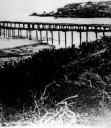In an email, Bruce Hayden writes:
I was reading your article [click here] on the battle to electrify Half Moon Bay. I find it interesting as I am retired from PG&E and at one time worked in Berkeley and Richmond area in the mid 60’s. Great Western and PG&E were also rivals there. It was interesting as construction standards for each was different as well as working on some structures that were installed prior to 1920 gave you a sense of history of the two companies.
In the 70’s I transferred to Auburn eventually ending my career in the transmission department where I had access to the old hydro generation plants some of which have been operating as far back as 1890, many of course were on line in 1910-1920.
Steel transmission towers were constructed from Drum Power House to Newark in 1912. I researched a Rite-a-way easement once that had been purchased in 1890 for “electric poles and wire”.
The purchase of a Rite-a-way for one milk cow, another for a $20 gold piece.
I also enjoyed your article on Ken Kesey, and the “Search for Beatniks” [click here] which is how I came to your web site via a link that was posted on the Strawberry Music Festival list serv.
Bruce
—————————————————
P.S.
I just wrote you about PG&E and then I read Vietnam, I saw the picture of the Hand Book for Conscientious Objectors. I was a draft counselor for 4 years in Walnut Creek. This brought back memories of that time. I primarily dealt with CO’s, draft board appeals and preparation for court cases.
I understand very much why the present administration doesn’t want a draft, if they had one the country would be in an uproar over their policies.



